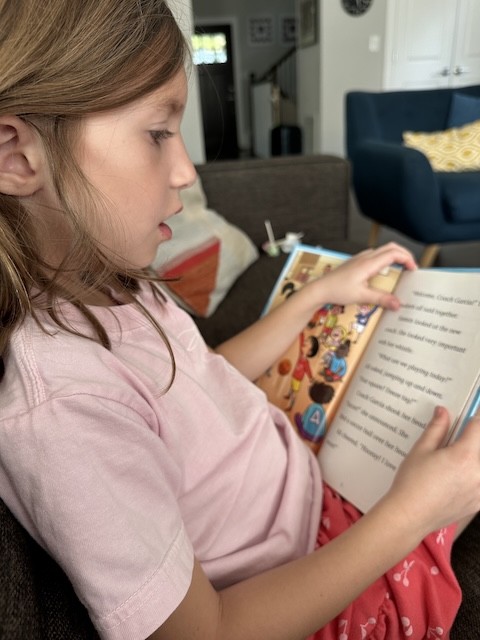Blast from the Past: This piece first appeared on June 4, 2022, and was re-released on July 26, 2025. I continue to feel strongly that speech-to-print is the best way to go when it comes to beginning phonics instruction, yet as this entry admits – that is not yet proven. That hasn’t changed over the past few years, and yet data continue to accumulate on that side of the ledger. For example, Yan, et al. (2024) demonstrate the importance of a neurological speech-to-print convergence in reading, something that suggests the potential value of such instructional approaches. Likewise, there is more evidence concerning the relationship between speech-to-print processing and word reading (Vandervelden, M., & Siegel, 2001). Other studies show the sensibility of the speech-to-print sequence in early literacy development (Rowe, Piestrzynski, Hadd, & Reiter, 2024). I’ve touched the piece up a bit, adding some history, but the point remains: we don’t know which approach is best, but until someone proves one to be better than the other, I’d bet on speech-to-print as the starting point.
Teacher question:
I know you typically don’t talk about specific programs, but I really would like to know your thoughts. I had always wanted more training in a structured literacy program/approach. I always thought Wilson, and specifically OG approaches, were the gold standards. More recently, I began reading about programs labeled as “speech to print.” Proponents of speech to print methods claim it is much faster to teach kids to read (and spell) than OG based approaches. Is there research to support this? Are these studies comparing programs based on OG (that mainly follow a more print to speech approach) and programs that are more specifically speech to print? Thank you!
Shanahan response:
You’re right. I rarely comment on specific programs. But I’m happy to discuss program research or how consistent with the research a specific aspect of a program might be.
Let’s start with the claim that Orton-Gillingham (OG) style programs are the “gold standard.”
To me, a gold standard for an instructional program would be an approach that consistently resulted in positive learning outcomes and did better than competing methods. This outperformance would be demonstrated by direct research comparisons, or by meta-analyses summarizing a bunch of disparate but related comparisons. Basically, a gold standard approach would result in more learning.
If OG was the gold standard, then it would reliably do better than other explicit decoding approaches in teaching kids to read.
Back in National Reading Panel (NRP, 2000) days, we analyzed evaluations of phonics instruction across 38 experimental and quasi-experimental studies – considering 18 different phonics curriculum sequences. Our conclusion? Phonics was a valuable ingredient in literacy teaching, and programs with explicit systematic phonics tended to outperform those that did not.
What about different types of phonics teaching? We made some of those comparisons, too. For instance, synthetic phonics (reading words from individual letters and sounds) resulted in higher average effects over analytic phonics (focused on syllables, morphemes, and use of known words as analogies), but this difference wasn’t statistically significant. Basically, there was no real difference in the effectiveness of synthetic and analytic phonics.
We didn’t compare individual phonics programs with each other because there were usually only one or two studies of most programs.
One exception to this was OG. There were enough studies of OG programs to allow the computation of a meaningful estimate of effectiveness. Nevertheless, we didn’t do that. I still think that was a good choice. I suspect those results would be a bit misleading. When OG failed, it was usually being delivered to severely disabled populations, including with kids so disabled that they were hospitalized. It is fair to say that OG didn’t do especially well with such kids. But none of the comparable programs were ever evaluated under those circumstances. There is no reason to think they would have done any better.
Over the past 25 years, more research has accumulated, and OG now has its very own meta-analysis (Stevens, Austin, Moore, Scammacca, Boucher, & Vaughn, 2021). That study found OG to be effective but with rather modest benefits – a lower degree of effectiveness than was reported for the average phonics program studied in the NRP report.
So much for being a gold standard!
Orton-Gillingham procedures are no more effective than any other explicit systematic phonics instruction – despite the religious fervor of some of its advocates.
Not surprising, those true believers argue against the data:
“They didn’t look at the right version of OG.”
“I do it a little differently than others and it really works well for my kids.”
“The newer trainers aren’t as good as the past ones, so they probably studied teachers who weren’t well trained.”
Those things are not more (or less) true of OG than any other phonics approach. If it’s so hard to find a potent version, then why would we expect it to be more effective than anything else?
There aren’t direct comparisons of OG with other phonics approaches, but generally it looks like it works about as well as any of them (and, sometimes, not as well).
That brings us to a second point – the one about speech-to-print instructional approaches.
I’ve oft grumbled about the lack of evaluation of individual features of complex instructional programs. Research may affirm the benefits of a multicomponent program without revealing which of its ingredients were active.
You’d think with all the interest in phonics there would be many such studies exploring the implications of sound tracing, analytic/synthetic approaches, grapheme-phoneme sequences, inclusion of morphological analysis, decodable text, emphasis on consistency versus flexibility, print-to-speech/speech-to-print approaches, dosage variation, decoding for older students, and so on.
Unfortunately, there are surprisingly few such research studies. Comparisons of print-to-speech and speech-to-print programs being one especially unfortunate area of neglect. We have some relevant research information about differences between those approaches – just nothing definitive.
Basically, speech-to-print approaches encourage students initially to perceive their language sounds prior to focusing their attention on the letters and spellings. As children become aware of the phonemic distinctions between words, then these perceived sounds are linked to their visual or print representations. Beyond that speech sound beginning, these teaching methods encourage much spelling and writing activity – actions that require students to think about what letters represent the language sounds and word pronunciations, rather than solely focusing on sounding out written words.
Phonics programs have usually emphasized print-to-speech. Kids are taught to identify letters, to link sounds to those letters, and then to sound out words by sounding each letter. Think about it. That instructional sequence is identical to the sequence readers must go through during reading: look at the letters and use that information to generate a phonological representation.
It seems reasonable to teach students explicitly what we eventually want them to do. That isn’t always the case, however. To be effective a curriculum design does not necessarily have to mirror the intended outcome quite this accurately. Learning to read and reading are not the same thing, and one doesn’t necessarily benefit from mirroring the other.
Perhaps the opposite – starting with phonemes and pronunciations and then connecting those to letters and printed words – might be a good idea. It’s possible that trying to spell and write words does more to enhance phonemic awareness and it may somehow make the phonology more prominent or easy to perceive (Wasowicz, 2021).
The possibility that kids might benefit more from speech-to-print than from print-to-speech first started to appear in the 1910s – in the work of Ernest Horn (1919). He explored the idea that spelling instruction and practice might benefit reading. Later, this notion gained purchase when Helen Murphy (1943) discovered that the ability to auditorily discriminate the phonemes in words was a powerful predictor of later reading progress, and she and her advisor, Donald Durrell, built this concept into their beginning reading program (Durrell, Sullivan & Murphy, 1945), a program that eventually morphed into Speech to Print Phonics (Durrell & Murphy, 1964).
When Jeanne Chall (1967) published her landmark review of phonics research, she concluded that those programs that included spelling, writing, and/dictation did better than those that did not.
I followed up on that in my reading-writing relationship research in the 1980s. I found spelling and decoding to be closely related, even when a lot of other variables were available to suck up the variance (Shanahan, 1984). Later, Ginger Berninger and her colleagues improved on that with even more ambitious efforts with the same results (Berninger, Abbott, Abbott, Graham, & Richards, 2002).
Marilyn Adams (1990) and Linnea Ehri (1997) both theorized on that possibility, and Steve Graham reported a meta-analysis that found spelling instruction improved reading – most likely because of its contribution to decoding (Graham & Santangelo, 2014).
But that evidence is all indirect. It suggests the value of the approach. It doesn’t prove it.
Not everyone agrees with my conclusion. Louisa Moats (1998, 2005, 2010), for example, has several publications that treat this as a settled matter, concluding that speech-to-print is best. There is a difference between what I believe and what I know. There is a preponderance of evidence on that side of the argument, but I’m not satisfied that it is yet proven.
Perhaps the closest thing we have to a direct test of the proposition is a meta-analysis of 11 studies (Weisler & Mathes, 2011). It concluded that instruction that integrated encoding into decoding instruction led to significantly higher reading achievement. Still not the strongest evidence – because it combined investigations that compared encoding with decoding (Christensen & Bowey, 2005) along with those that compared encoding instruction with things like extra math lessons (Graham, Harris, & Chorzempa, 2002).
No matter where the final evidence comes down, it should be remembered that at some point – any decoding program will necessarily shift its focus to print-to-speech, since that is what we do in reading. Until then, it is fair to conclude that there are real benefits to be derived from activities like explicit early instruction in phonemic awareness, invented spelling encouragement, explicit spelling instruction, word construction from sounds, and so on. These kinds of speech-to-print activities increase learning.
My advice: get a phonics program that includes such activities or layer them into a traditional print-to-speech program (including OG).
References
Adams, M. (1990) Beginning to read: Thinking and learning about print. Cambridge, MA: MIT Press.
Berninger, V. W., Abbott, R. D., Abbott, S. P., Graham, S., & Richards, T. (2002). Writing and reading: Connections between language by hand and language by eye. Journal of Learning Disabilities, 35(1), 39–56. https://doi.org/10.1177/002221940203500104
Chall, J.S. (1967). Reading: The great debate. New York: McGraw-Hill.
Durrell, D. D., Sullivan, H. B., and Murphy, H. A. (1945). Building word power. Yonkers on Hudson: World Book Co.
Durrell, D. & Murphy, H. A. (1964). Speech to print phonics. New York: Harcourt Brace and Jovanovich.
Ehri, L. C. (1997). Learning to read and learning to spell are one and the same, almost. In C. A. Perfetti, L. Rieben, & M. Fayol (Eds.), Learning to spell (pp. 237-269). Hillsdale, NJ: Erlbaum.
Graham, S., & Santangelo, T. (2014). Does spelling instruction make students better spellers, readers, and writers? A meta-analytic review. Reading and Writing, 27, 1703-1743. DOI:10.1007/s11145-014-9517-0
Horn, E. (1919). Principles of method in teaching spelling as derived from scientific investigation. Teachers College Record, 20(7), 52-77.
https://doi.org/10.1177/016146811902000703
Moats, L.C. (1998). Teaching decoding. American Educator, 22(1), 1-9.
Moats, L. C. (2005). How spelling supports reading and why it is more regular and predictable than you may think. American Educator, 29(4), 12-22, 42-43.
Moats, L. C. (2010). Speech to print: Language essentials for teachers. Baltimore, MD: Brookes.
Murphy, Helen A. (1943). An evaluation of the effect of specific training in auditory and visual discrimination of beginning reading. Unpublished doctoral dissertation, Boston University
National Reading Panel (U.S.) & National Institute of Child Health and Human Development (U.S.). (2000). Report of the National Reading Panel: Teaching children to read : an evidence-based assessment of the scientific research literature on reading and its implications for reading instruction. U.S. Dept. of Health and Human Services, Public Health Service, National Institutes of Health, National Institute of Child Health and Human Development.
Rowe, D. W., Piestrzynski, L., Hadd, A. R. and Reiter, J. W. (2024). Writing as a path to the alphabetic principle: How preschoolers learn that their own writing represents speech. Reading Research Quarterly, 59: 32-56. https://doi.org/10.1002/rrq.526
Shanahan, T. (1984). Nature of the reading-writing relation: An exploratory multivariate analysis. Journal of Educational Psychology, 76, 466–477.
Stevens, E.A., Austin, C., Moore, C., Scammacca, N., Boucher, A.N., & Vaughn, S. (2021). Current state of the evidence: Examining the effects of Orton-Gillingham reading interventions for students with or at risk for word-level reading disabilities. Exceptional Children, 87(4), 397-417.
Vandervelden, M., & Siegel, L. (2001). Phonological processing in written word learning: Assessment for children who use argumentative and alternative communication. Argumentative and Alternative Communication, 17(1), 37-51. https://doi.org/10.1080/aac.17.1.37.51
Wasowicz, J. (2021). A speech-to-print approach to teaching reading. LDA Bulletin, 53(2), 10-18.
Weiser, B., & Mathes, P. (2011). Using encoding instruction to improve the reading and spelling performances of elementary students at risk for literacy difficulties: A best-evidence synthesis. Review of Educational Research, 81(2), 17-200.
Yan, X., Yang, F., Feng, G., Li, H., Su, H., Liu, X., Wu, Y. Hua, J., & Cao, F. (2024). Reading disability is characterized by reduced print-speech convergence. Child Development, 95(6), 1982-1999. https://doi.org/10.1111/cdeve.14134
LISTEN TO MORE: Shanahan On Literacy Podcast







Comments
See what others have to say about this topic.